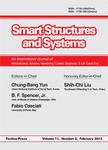版权所有:内蒙古大学图书馆 技术提供:维普资讯• 智图
内蒙古自治区呼和浩特市赛罕区大学西街235号 邮编: 010021

作者机构:Univ Guilan Fac Engn Dept Civil Engn Rasht Iran
出 版 物:《SMART STRUCTURES AND SYSTEMS》 (智能结构与系统)
年 卷 期:2018年第21卷第3期
页 面:359-371页
核心收录:
学科分类:08[工学] 0804[工学-仪器科学与技术] 0802[工学-机械工程] 0813[工学-建筑学] 0814[工学-土木工程]
主 题:weakening and damping negative stiffness device MR damper inverse model velocity control algorithm smart base-isolated
摘 要:Strong seismic events commonly cause large drift and deformation, and functionality failures in the superstructures. One way to prevent functionality failures is to design structures which are ductile and flexible through yielding when subjected to strong ground excitations. By developing forces that assist motion as negative stiffness forces, yielding can be achieved. In this paper, we adopt the weakening and damping method to achieve a new approach to reduce all of the structural responses by further adjusting damping phase. A semi-active control system is adopted to perform the experiments. In this adaptation, negative stiffness forces through certain devices are used in weakening phase to reduce structural strength. Magneto-rheological (MR) dampers are then added to preserve stability of the structure. To adjust the voltage in MR dampers, an inverse model is employed in the control system to command MR dampers and generate the desired control forces, where a velocity control algorithm produces initial required control force. An extensive numerical study is conducted to evaluate proposed methodology by using the smart base-isolated benchmark building. Totally, nine control systems are examined to study proposed strategy. Based on the numerical results of seven earthquakes, the use of proposed strategy not only reduces base displacements, base accelerations and base shear but also leads to reduction of accelerations and inter story drifts of the superstructure. Numerical results shows that the usage of inverse model produces the desired regulated damping, thus improving the stability of the structure.